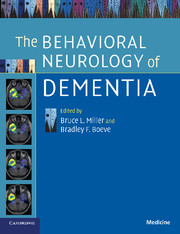Book contents
- Frontmatter
- Contents
- List of contributors
- Section 1 Introduction
- 1 Basic clinical approaches to diagnosis
- 2 Dementia with Lewy bodies
- 3 Neurogenetics of dementia
- 4 Frontotemporal dementia
- 5 Alzheimer's disease
- 6 Mental status examination
- 7 Neuropsychiatric features of dementia
- 8 Neuroimaging in dementia
- 9 Epidemiology and risk factors
- 10 Animal models of dementia
- 11 Neuropathology of dementia
- Section 2 Cognitive impairment, not demented
- Section 3 Slowly progressive dementias
- Section 4 Rapidly progressive dementias
- Index
- References
8 - Neuroimaging in dementia
Published online by Cambridge University Press: 31 July 2009
- Frontmatter
- Contents
- List of contributors
- Section 1 Introduction
- 1 Basic clinical approaches to diagnosis
- 2 Dementia with Lewy bodies
- 3 Neurogenetics of dementia
- 4 Frontotemporal dementia
- 5 Alzheimer's disease
- 6 Mental status examination
- 7 Neuropsychiatric features of dementia
- 8 Neuroimaging in dementia
- 9 Epidemiology and risk factors
- 10 Animal models of dementia
- 11 Neuropathology of dementia
- Section 2 Cognitive impairment, not demented
- Section 3 Slowly progressive dementias
- Section 4 Rapidly progressive dementias
- Index
- References
Summary
Introduction
Despite the tremendous technological advancement in medicine, diagnosis of dementia caused by neurodegenerative disease continues to be made almost exclusively based on the clinical interpretation of patients' symptoms, supported by cognitive assessment with neuropsychological testing. Not surprisingly, the accuracy of diagnosis varies with the expertise of the center where a patient is evaluated, and with the rarity of the clinical presentation. For unusual clinical presentations, accuracy can be disappointingly low. In addition, diagnosis of neurodegenerative diseases that cause dementia is currently not made until an individual's level of cognitive impairment has already robbed them of their ability to work and perform other functions important for self-esteem and independence, such as driving and management of their finances.
The introduction of computed tomographic (CT) scanning in the 1970s offered the possibility of safe, non-invasive visualization of the human brain in vivo. Since that time, the chief goals for brain imaging in dementia have been quite simple: first, to facilitate early diagnosis by differentiating patients with neurodegenerative disease from normal individuals at the earliest possible time in the illness; and, second, to differentiate various causes of neurodegeneration, such as Alzheimer's disease (AD), frontotemporal dementia (FTD), dementia with Lewy bodies (DLB), corticobasal degeneration (CBD) and progressive supranuclear palsy (PSP), from each other. While early diagnosis offers the best opportunity for preserving function, accurate diagnosis is critical so that treatments can be tailored to the specific disease. The first step toward achieving these goals is the exclusion of non-neurodegenerative diseases mimicking neurodegenerative dementias.
- Type
- Chapter
- Information
- The Behavioral Neurology of Dementia , pp. 101 - 119Publisher: Cambridge University PressPrint publication year: 2009
References
- 1
- Cited by

